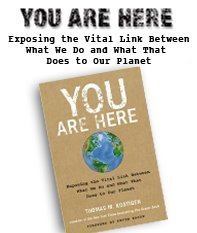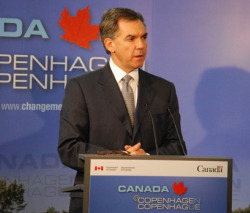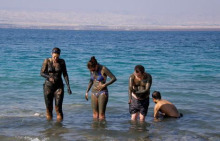Matt Rees's Blog - Posts Tagged "environment"
The Writing Life: Thomas M. Kostigen

Thomas M. Kostigen is the most important environmental writer in the U.S. That’s not only because he’s trekked through the Amazon to record how we’re destroying it, or because he climbed into the Fresh Kills landfill on Staten Island to…smell how badly it stinks. Or because his ground-breaking New York Times bestseller The Green Book gave us all a checklist for ways to improve the environment around us. It’s also because when he writes about these vital issues he does it with a vibrant touch that brings a sometimes dry scientific and political issue to life. For this reason – if not also for the diversity of his writing experience, as a financial writer, playwright, and screenwriter -- I asked the Santa Monica-based Kostigen to talk about The Writing Life.
How long did it take you to get published?
I actually started writing in college. I interned at a local newspaper that happened to win the Pulitzer Prize while I was working there. So I had these great clips to go along with my degree. From there, well, I continued to publish in newspapers, magazines and wire services. I ghost-wrote a couple of books in my early twenties. I also wrote some plays that were produced, a film, and then turned to books. My first book came a decade after college.
Would you recommend any books on writing?
I think Syd Field's book on screenwriting applies to all writing forms because it's about process, structure and tenacity. But really the best books are authors' memoirs or autobiographies.
What’s a typical writing day?
I write every day. Every day! Usually I get informed in the morning. By that I mean reading a lot of newspapers, blogs, and the wires. This helps me wake up and usually sparks an idea or two. I'm an early riser, so by 8 a.m. I am a pot of coffee into the day and cranking away at my quota. I aim for a thousand words a day.

Plug your latest book. What’s it about? Why’s it so great?
My latest book is entitled You Are Here: Exposing the Vital Link Between What We Do and What That Does to Our Planet. I traveled around the world to very exotic locales to research how we affect the planet by the simple, everyday things we do in our lives. It's great because it's an adventure story as well as a book that has information that can change the world for the better.
How much of what you do is completely original?
I write nonfiction. And while I try to write in my own unique voice, I do rip off Bowles, Theroux, and Chatwin...
What’s your favorite sentence in all literature, and why?
"For sale: baby shoes, never worn." Hemingway wrote that as supposedly his shortest, short story. And he thought it his best work, or so it's said. Anyway, I like it.
What’s the best descriptive image in all literature?
I think John Irving's description of Owen Meany is up there. He made me hear Meany's voice. Quite a feat for a writer...
Who’s the greatest stylist currently writing?
I'd have to give that to DeLillo. His rhythm is unmatched, and he really shades things nicely.
Who’s the greatest plotter currently writing?
Rushdie. Who can think like that?
How much research is involved in each of your books?
As a nonfiction writer, I put an enormous amount of research in everything. (I have to footnote.) Memoir editors take note.
What’s your experience with being translated?
I've been translated into about a dozen different languages. My only problem is with Chinese grammar. (They never get it right!) I also learned that my last name in Swedish means "cow path." Hmm....
Do you live entirely off your writing? How many books did you write before could make a living at it?
I've actually always lived solely off my writing. Now, I live off my books and my freelance journalism. I started making real money after one of my books hit the New York Times best seller list. That moniker gives you lots of cred.
How many books did you write before you were published?
I finished two full manuscripts before I got anything published by a house.
What’s the strangest thing that happened to you on a book tour?
Ah. Funny story. I was met by my author escort at the airport. She looked exactly like Kathy Bates in Misery. She had double parked her junk car at the sidewalk and got a ticket. An old pizza box was on the passenger seat, which she cleared for me to sit on. After the death ride to my first talk, I came out to find her -- and she had gone. Never saw her again. Crazy.
What’s your weirdest idea for a book you’ll never get to publish?
The History of the Pogo Stick.
Published on April 23, 2009 22:28
•
Tags:
environment, kostigen, life, writers, writing
Israel's new weapon: water?
Yet another report accuses Israel of human rights abuses, this time for denying Palestinians water. By Matt Beynon Rees - GlobalPost
JERUSALEM — Human-rights reports condemning Israel’s dealings with the Palestinians have become so frequent of late they’re like the dripping of Chinese water torture.
In the last few months, there have been reports on the conduct of Israeli forces in Gaza, on restrictions on medical supplies and food entering Gaza and the necessity for a boycott of Israeli products and people. This week Amnesty International made its latest contribution with a report on water itself.
Amnesty issued a 112-page report that accuses Israel of denying sufficient water to Palestinians in the West Bank and the Gaza Strip. The report says Israelis uses more than three times as much water per person as Palestinians, and that Gazans are down to 20 liters of water a day — the World Health Organization’s designated minimum level for subsistence.
“Water is a basic need and a right, but for many Palestinians obtaining even poor-quality, subsistence-level quantities of water has become a luxury that they can barely afford,” said Amnesty's researcher for Israel and the Palestinian territories Donatella Rovera.
Palestinian officials gushed about the Amnesty report. Israelis told them to suck it up.
A measure of the importance of water in the Israeli-Palestinian conflict — and throughout the parched Middle East — is the position water rights were given in the Oslo Peace Accords between the two sides.
When the peace agreement was signed in 1993, the most difficult issues were set aside for “final-status negotiations.” In other words, the two sides figured they’d be able to agree on some issues only when they’d already made nice for a few years, their people would’ve seen the benefits of early measures, and consequently would accept compromise on the toughest questions.
Those tough questions, by the way, were: the status of Jerusalem, the future of Palestinian refugees, the final borders of a Palestinian state.
And water.
The first three issues are essentially at the heart of every story you read every day about this conflict. Water, on the other hand, doesn’t get so much coverage.
Because it’s harder to deal with than any of the others.
That’s right. You can pay refugees to make new lives in the West Bank and Gaza or Sweden. You can draw a line on a map and call one side of the line “Palestine.” You can even give sovereignty over the Temple Mount above ground to the Palestinians and underground (where all their ancient relics are) to the Israelis.
But you can’t make more water.
There are three main sources of water for Israel and the Palestinians, and they’re all in rotten shape.
The Sea of Galilee, according to Israeli government water officials, is so low after a decade of droughts that another winter of light rainfall could turn it into a “dead lake.” In other words, the water would become contaminated. Fears such as this led Israel’s Water Authority this summer to institute higher charges for homes that use large amounts of water.
Contamination isn’t a fear for the coastal aquifer, which runs beneath Gaza. It’s already a reality. The aquifer has been over-pumped, so that sea water has leeched into it and untreated sewage from the 1.5 million Palestinians living on top of it has seeped down into it. That’s led to dangerous quantities of nitrates in the water pumped out of the ground in Gaza.
The mountain aquifer beneath the West Bank is little better. Amnesty says Israel pumps 80 percent of the water that comes out of the mountain source, leaving only 20 percent to the Palestinians.
Israeli officials argue that they then sell much of that water back to the Palestinian Authority as they’re mandated to do under their peace accords (Article 40 of Annex III, to be precise). They also contend that the Palestinian Authority refuses to recycle its waste water, doesn’t build water plants even when Israel gives a permit to do so and has frittered away billions of dollars in Western aid without setting up its own water infrastructure (or pretty much any other infrastructure, in fact).
To be sure, the World Bank conceded recently that the Palestinian Water Authority is “in total chaos.” In most of the Palestinian villages of the West Bank, water is trucked in by leaky, old tankers, which sometimes fail to make it past Israeli military checkpoints.
Amnesty contends that Palestinians consume an average of 70 liters of water a day, including agricultural use. Much less than the Israeli average of 300 liters.
Israel disagrees with those figures. The Israeli Water Authority says Israelis use 408 liters a day of fresh water from natural sources, while Palestinians use 200 liters.
Those numbers won’t wash with Amnesty, which points the finger at Israeli settlements in the West Bank as big users of local water resources. Certainly the settlements have a lusher look than the neighboring Palestinian villages.
The language of Amnesty’s report highlights that water is not merely something that’s drunk or used for irrigation. The report "calls on the Israeli authorities to urgently address the desperate need for water security in the [occupied Palestinian territories:].”
“Water security.” Like everything else in the Middle East, water has turned into a security issue. In other words, something that can lead to violence.
Behind the politics, Amnesty points out the specific and pressing problems of the people of Gaza. The three-week Israeli offensive against Hamas in Gaza which ended in mid-January this year destroyed much of the infrastructure, such as it was.
Since then Israel has restricted construction materials entering the Gaza Strip, because it fears Hamas will use them to rebuild military facilities and weapons-smuggling tunnels beneath the Egyptian border. That, according to Amnesty, has brought the water situation in Gaza to “crisis point.”
Unfortunately the fact that water was supposed to be left to “final-status” peace negotiations means that there’s likely to be little change in the situation now. Final-status talks are a long, long way off. Palestinian negotiators have refused to talk to their Israeli counterparts until construction in Israeli settlements is at a complete halt. That means no water talks, either.
JERUSALEM — Human-rights reports condemning Israel’s dealings with the Palestinians have become so frequent of late they’re like the dripping of Chinese water torture.
In the last few months, there have been reports on the conduct of Israeli forces in Gaza, on restrictions on medical supplies and food entering Gaza and the necessity for a boycott of Israeli products and people. This week Amnesty International made its latest contribution with a report on water itself.
Amnesty issued a 112-page report that accuses Israel of denying sufficient water to Palestinians in the West Bank and the Gaza Strip. The report says Israelis uses more than three times as much water per person as Palestinians, and that Gazans are down to 20 liters of water a day — the World Health Organization’s designated minimum level for subsistence.
“Water is a basic need and a right, but for many Palestinians obtaining even poor-quality, subsistence-level quantities of water has become a luxury that they can barely afford,” said Amnesty's researcher for Israel and the Palestinian territories Donatella Rovera.
Palestinian officials gushed about the Amnesty report. Israelis told them to suck it up.
A measure of the importance of water in the Israeli-Palestinian conflict — and throughout the parched Middle East — is the position water rights were given in the Oslo Peace Accords between the two sides.
When the peace agreement was signed in 1993, the most difficult issues were set aside for “final-status negotiations.” In other words, the two sides figured they’d be able to agree on some issues only when they’d already made nice for a few years, their people would’ve seen the benefits of early measures, and consequently would accept compromise on the toughest questions.
Those tough questions, by the way, were: the status of Jerusalem, the future of Palestinian refugees, the final borders of a Palestinian state.
And water.
The first three issues are essentially at the heart of every story you read every day about this conflict. Water, on the other hand, doesn’t get so much coverage.
Because it’s harder to deal with than any of the others.
That’s right. You can pay refugees to make new lives in the West Bank and Gaza or Sweden. You can draw a line on a map and call one side of the line “Palestine.” You can even give sovereignty over the Temple Mount above ground to the Palestinians and underground (where all their ancient relics are) to the Israelis.
But you can’t make more water.
There are three main sources of water for Israel and the Palestinians, and they’re all in rotten shape.
The Sea of Galilee, according to Israeli government water officials, is so low after a decade of droughts that another winter of light rainfall could turn it into a “dead lake.” In other words, the water would become contaminated. Fears such as this led Israel’s Water Authority this summer to institute higher charges for homes that use large amounts of water.
Contamination isn’t a fear for the coastal aquifer, which runs beneath Gaza. It’s already a reality. The aquifer has been over-pumped, so that sea water has leeched into it and untreated sewage from the 1.5 million Palestinians living on top of it has seeped down into it. That’s led to dangerous quantities of nitrates in the water pumped out of the ground in Gaza.
The mountain aquifer beneath the West Bank is little better. Amnesty says Israel pumps 80 percent of the water that comes out of the mountain source, leaving only 20 percent to the Palestinians.
Israeli officials argue that they then sell much of that water back to the Palestinian Authority as they’re mandated to do under their peace accords (Article 40 of Annex III, to be precise). They also contend that the Palestinian Authority refuses to recycle its waste water, doesn’t build water plants even when Israel gives a permit to do so and has frittered away billions of dollars in Western aid without setting up its own water infrastructure (or pretty much any other infrastructure, in fact).
To be sure, the World Bank conceded recently that the Palestinian Water Authority is “in total chaos.” In most of the Palestinian villages of the West Bank, water is trucked in by leaky, old tankers, which sometimes fail to make it past Israeli military checkpoints.
Amnesty contends that Palestinians consume an average of 70 liters of water a day, including agricultural use. Much less than the Israeli average of 300 liters.
Israel disagrees with those figures. The Israeli Water Authority says Israelis use 408 liters a day of fresh water from natural sources, while Palestinians use 200 liters.
Those numbers won’t wash with Amnesty, which points the finger at Israeli settlements in the West Bank as big users of local water resources. Certainly the settlements have a lusher look than the neighboring Palestinian villages.
The language of Amnesty’s report highlights that water is not merely something that’s drunk or used for irrigation. The report "calls on the Israeli authorities to urgently address the desperate need for water security in the [occupied Palestinian territories:].”
“Water security.” Like everything else in the Middle East, water has turned into a security issue. In other words, something that can lead to violence.
Behind the politics, Amnesty points out the specific and pressing problems of the people of Gaza. The three-week Israeli offensive against Hamas in Gaza which ended in mid-January this year destroyed much of the infrastructure, such as it was.
Since then Israel has restricted construction materials entering the Gaza Strip, because it fears Hamas will use them to rebuild military facilities and weapons-smuggling tunnels beneath the Egyptian border. That, according to Amnesty, has brought the water situation in Gaza to “crisis point.”
Unfortunately the fact that water was supposed to be left to “final-status” peace negotiations means that there’s likely to be little change in the situation now. Final-status talks are a long, long way off. Palestinian negotiators have refused to talk to their Israeli counterparts until construction in Israeli settlements is at a complete halt. That means no water talks, either.
Published on October 29, 2009 08:17
•
Tags:
aid, bank, crime, east, environment, fiction, gaza, global, hamas, international, israel, journalism, middle, palestinians, post, west
My part in saving the environment

I like to do my bit to help the effort to save our planet. Last week in Rome my wife and I confronted a brand new recycling program which, mainly, seemed to consist of workmen loading enormous amounts of bottles into their tiny dump truck outside our window at 5 a.m. We cheered them on and put our bottles in the right bin. Unbeknownst to me, my Palestinian crime novels also played a part in the Copenhagen climate summit by providing solace and welcome distraction to Jim Prentice, the Canadian Environment Minister. In the National Post, Jim writes: "Ian Rankin is always reliable, and his latest book, Doors Open, is a good yarn. More recently, I have turned to new writers like Matt Beynon Rees, the former Jerusalem bureau chief for Time. He has introduced me to his series detective, Omar Yussef, and a new setting: the Middle East. My favourites, The Collaborator of Bethlehem and, currently, A Grave in Gaza, are hard to put down." You see, even if you're about to try to save the planet alongside the world's other Environment honchos, it's still hard to take a break from reading my books. As Canada's environment is one of the loveliest in the world, I'm rather pleased about this. Thanks for reading, Jim.
Published on December 25, 2009 01:59
•
Tags:
bethlehem, canada, collaborator, denmark, environment, gaza, grave, omar, ontario, palestinians, yussef
What's floating in the Dead Sea?
 If you’ve ever slathered your skin in the healing, mineral-rich mud of the Dead Sea, you may want to stop reading now.
If you’ve ever slathered your skin in the healing, mineral-rich mud of the Dead Sea, you may want to stop reading now.More than 8 million gallons of sewage from East Jerusalem is pumped downhill to the Dead Sea, raw and untreated, every day. That’s not just a little icky for those of us who like to float in the lowest body of water on earth. It’s also an environmental catastrophe, and potentially another flashpoint in the conflict between Israelis and Palestinians.
“It’s the greatest environmental hazard in the country,” said Naomi Tzur, Jerusalem’s deputy mayor, who heads the planning and environmental committees on the city council. “I don’t sleep easily at night knowing that this is happening.”
The Dead Sea is one of the contenders to be named among the Seven Natural Wonders of the World in an online poll that organizers estimate will draw a billion voters by the time results are announced next year. But its location also puts it in the firing line of a conflict almost as bitter as the sea’s highly saline water.
Read the rest of this post at my blog The Man of Twists and Turns.
Published on June 27, 2010 08:08
•
Tags:
bustan, dead-sea, east-jerusalem, environment, germany, israel, kidron-valley, middle-east, palestinians, sewage



